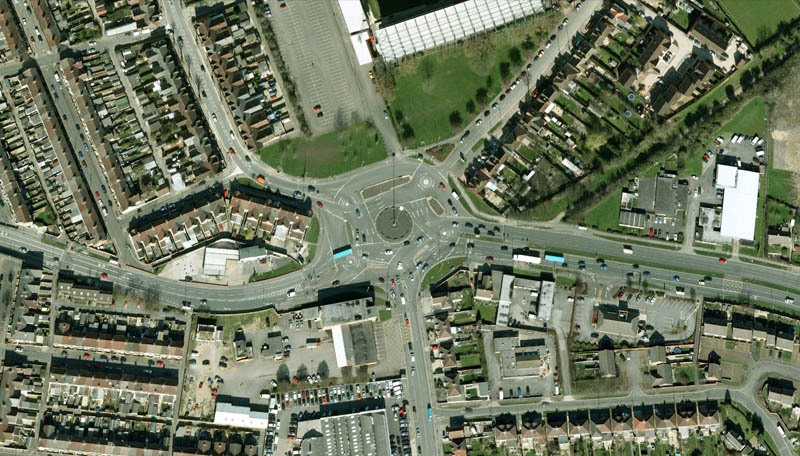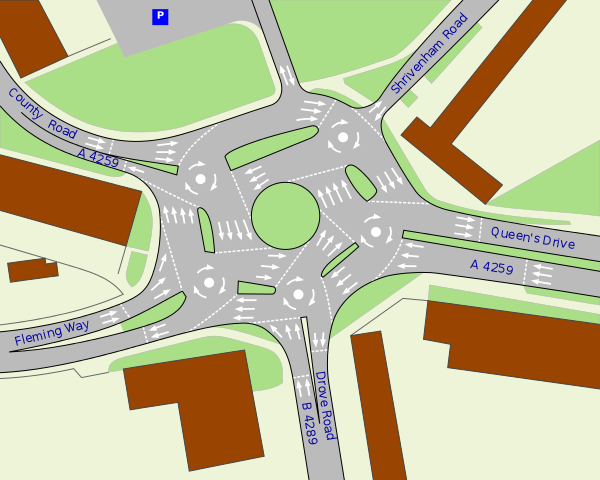Magical roundabout: a world tour of the most difficult road junction in the world

Roundabouts, popular in different countries, particularly in the UK, are obviously more effective than full-stop intersections or other types of intersections. But in many places, including the United States, they did not find recognition.
There are several explanations for this. Some experts point to a historical difference in the evolution of infrastructures and directions of government investment, while others argue that the British culture of teamwork is not compatible with the American mentality. Or, perhaps, the Americans once looked at this outcome and rushed off into the night with cries of horror.
')
In Swindon (England) there is perhaps one of the most incomprehensible looking intersections ever created by man: the first in the world “Magic Circular Interchange”, also known as the “roundabout”.
A complex interchange consists of five separate smaller roundabouts, directing traffic in a clockwise direction and located around one central ring, working counterclockwise.

Motion Chart
Despite the terrible appearance, such a configuration is much more efficient than ordinary roundabouts, and it was adopted for implementation in other parts of Britain.

Each of the external circles serves the entry of cars and their departure from the corresponding road. Experienced drivers can drive through the junction in a more efficient way and save time. Less experienced can move with the flow, circling the edges, until they reach the desired exit. For drivers following from one end of the junction to the opposite, the journey of the Magic roundabout may take half the time than the intersection of the standard junction.
Traffic jams in Swindon were seriously reduced due to the design of this junction, even with the gradual increase in traffic. But the subjective opinions of drivers unfamiliar with it may differ from each other.
The outcome was developed by engineer Frank Blackmore [Frank Blackmore], who worked at the Laboratory of British Transport and Road Studies. The famous interchange in Swindon today appeared in 1972. Initially, it was called the County Islands, but it was quickly dubbed the “Magic roundabout,” and as a result this name became official.
Blackmore developed its design, comparing single circular intersections with alternative straight-line ones, and then began to add double, triple and quadruple variants:

First, at the junction all the time there were traffic police, designed to help drivers. A successful experiment led to their replacement by road signs.

But the Magic roundabout has its critics. The British insurance company called her the worst in the world, she received the same epithet from one of the automobile magazines and she also got into the ten most terrible outcomes according to a BBC News survey.
Despite the negative reviews in the press, the junction in Swindon is surprisingly excellent in terms of safety and efficacy. A very complicated type of junction hides a fairly simple set of rules for drivers:
- Avoid collisions;
- Follow the lines and arrows;
- Skip the people already at the junction;
- Follow up to your goal.
Tom Scott, the producer of the following video, compares the external impression of the disorder reigning at the junction with the complex behavior of groups of birds. As he notes in the video, even a few simple rules can lead to what the outsider looks like the chaotic behavior of bird flocks.
The key feature of the junction is the simplicity of the rules. Efficiency is achieved by reducing the speed of traffic and increasing the attention of drivers. At uncontrolled intersections, both circular and normal, drivers usually follow the road and the environment more closely, based on their considerations, and not on signals and signs.
There are even people agitating for the extreme expansion of this principle, for the “common space” free from traffic lights, signs, pavements and markings. This type of traffic control is not as comfortable, but the attention to drivers it generates causes the latter to follow the road, bicycles and pedestrians as well as the road ahead.
Source: https://habr.com/ru/post/372543/
All Articles